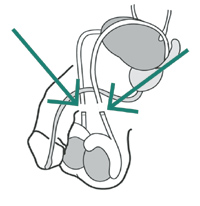Chapter 13 Download Chapter
How Effective?
One of the most effective methods but carries a small risk of failure:
- Among the partners of men who have vasectomies, far less than 1 in every 100 will become
 pregnant in the first year of use of the method. In fact, less than 2 women in every 1,000 will become pregnant. This means that 998 or 999 of 1,000 women whose partners have had vasectomy will not become pregnant.
pregnant in the first year of use of the method. In fact, less than 2 women in every 1,000 will become pregnant. This means that 998 or 999 of 1,000 women whose partners have had vasectomy will not become pregnant. - Sometimes men can have their semen examined at 3 months after the procedure to see if it still contains sperm. If no sperm is found, 1 woman in every 1,000 of these men’s partners will become pregnant in the first year.
- Among partners of men who do not have their semen examined, pregnancies are slightly more common, but still less than 2 per 1,000 women.
- Vasectomy is not fully effective for 3 months after the procedure.
- Some pregnancies occur within the first year because the couple does not use condoms or another effective method consistently and correctly in the first 3 months, before the vasectomy is fully effective.
- A small risk of pregnancy remains beyond the first year after the vasectomy and until the man’s partner reaches menopause.
- Over 3 years of use: About 4 pregnancies per 1,000 women

- Over 3 years of use: About 4 pregnancies per 1,000 women
- If the partner of a man who has had a vasectomy becomes pregnant, it may be because:
- The couple did not always use another method during the first 3 months after the procedure
- The provider made a mistake
- The cut ends of the vas deferens grew back together
Fertility does not return because vasectomy generally cannot be stopped or reversed. The procedure is intended to be permanent. Reversal surgery is difficult, expensive, and not available in most areas. When performed, reversal surgery often does not lead to pregnancy (see Question 7).
Protection against sexually transmitted infections (STIs): None.